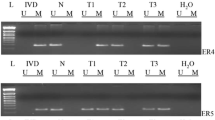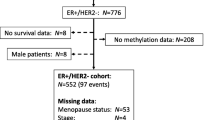Abstract
Estrogen receptor α (ER) and its ligand estrogen play vital roles in the development, progression and treatment of breast cancer. An increasing number of studies have also provided evidence linking disruption of the Fanconi anemia/BRCA cascade to breast cancer. Our objectives were to examine the methylation status and expression profiles of ER, correlate the findings with BRCA1 and FANCF methylation and map the critical CpGs for ER expression. We found that the CpG islands in the 5′ region of the ER gene are methylated in 59 of 120 (49.2%) primary breast cancers, including 45 of 59 ER-negative tumors (76.3%, P < 0.00001). In addition, we observed a strong correlation between ER promoter and BRCA1 promoter methylation (odds ratio 3.12, 95% confidence interval 1.10–9.68, P = 0.02). In contrast, FANCF methylation was rare in breast tumors: one of 120 (0.8%). ER methylation was associated with high tumor grade (60.4% methylated vs. 39.6% unmethylated in grade 3 tumors, P = 0.04) and tumor subtype (P = 0.03). Though small in number, all tumors of the medullary subtype were ER methylated. In contrast, the lobular subtype had the least methylation (23.1% methylated vs. 76.9% unmethylated). After treatment of MDA-MB-231 cells with 5-aza-cytidine (5-aza-dC) and trichostatin, which resulted in re-expression of ER mRNA, we localized dramatic demethylation effects to CpG islands in positions +68, +165, +192, +195, +337, +341 and +405 from transcription start site of the ER promoter. These data suggest that unlike FANCF, both ER and BRCA1 are specifically targeted for methylation in sporadic breast cancers, a phenomenon that should be explored for development of novel diagnostic and therapeutic approaches.



Similar content being viewed by others
References
Jordan VC (2004) Selective estrogen receptor modulation: concept and consequences in cancer. Cancer Cell 5(3):207–213
Hortobagyi GN (1998) Treatment of breast cancer. N Engl J Med 339(14):974–984
Pinzone JJ, Stevenson H, Strobl JS, Berg PE (2004) Molecular and cellular determinants of estrogen receptor alpha expression. Mol Cell Biol 24(11):4605–4612
Ottaviano YL, Issa JP, Parl FF, Smith HS, Baylin SB, Davidson NE (1994) Methylation of the estrogen receptor gene CpG island marks loss of estrogen receptor expression in human breast cancer cells. Cancer Res 54(10):2552–2555
Lapidus RG, Nass SJ, Butash KA, Parl FF, Weitzman SA, Graff JG, Herman JG, Davidson NE (1998) Mapping of ER gene CpG island methylation-specific polymerase chain reaction. Cancer Res 58(12):2515–2519
Catteau A, Morris JR (2002) BRCA1 methylation: a significant role in tumour development? Semin Cancer Biol 12(5):359–371
Vaziri SA, Krumroy LM, Elson P, Budd GT, Darlington G, Myles J, Tubbs RR, Casey G (2001) Breast tumor immunophenotype of BRCA1-mutation carriers is influenced by age at diagnosis. Clin Cancer Res 7(7):1937–1945
Wei M, Grushko TA, Dignam J, Hagos F, Nanda R, Sveen L, Xu J, Fackenthal J, Tretiakova M, Das S et al (2005) BRCA1 promoter methylation in sporadic breast cancer is associated with reduced BRCA1 copy number and chromosome 17 aneusomy. Cancer Res 65(23):10692–10699
Lyakhovich A, Surralles J (2006) Disruption of the Fanconi anemia/BRCA pathway in sporadic cancer. Cancer Lett 232(1):99–106
Garcia-Higuera I, Taniguchi T, Ganesan S, Meyn MS, Timmers C, Hejna J, Grompe M, D’Andrea AD (2001) Interaction of the Fanconi anemia proteins and BRCA1 in a common pathway. Mol Cell 7(2):249–262
Taniguchi T, Tischkowitz M, Ameziane N, Hodgson SV, Mathew CG, Joenje H, Mok SC, D’Andrea AD (2003) Disruption of the Fanconi anemia-BRCA pathway in cisplatin-sensitive ovarian tumors. Nat Med 9(5):568–574
Olopade OI, Wei M (2003) FANCF methylation contributes to chemoselectivity in ovarian cancer. Cancer Cell 3(5):417–420
Grushko TA, Blackwood MA, Schumm PL, Hagos FG, Adeyanju MO, Feldman MD, Sanders MO, Weber BL, Olopade OI (2002) Molecular-cytogenetic analysis of HER-2/neu gene in BRCA1-associated breast cancers. Cancer Res 62(5):1481–1488
Herman JG, Graff JR, Myohanen S, Nelkin BD, Baylin SB (1996) Methylation-specific PCR: a novel PCR assay for methylation status of CpG islands. Proc Natl Acad Sci USA 93(18):9821–9826
Matros E, Wang ZC, Lodeiro G, Miron A, Iglehart JD, Richardson AL (2005) BRCA1 promoter methylation in sporadic breast tumors: relationship to gene expression profiles. Breast Cancer Res Treat 91(2):179–186
Navari JR, Roland PY, Keh P, Salvesen HB, Akslen LA, Iversen OE, Das S, Kothari R, Howey S, Phillips B (2000) Loss of estrogen receptor (ER) expression in endometrial tumors is not associated with de novo methylation of the 5′ end of the ER gene. Clin Cancer Res 6(10):4026–4032
Batova A, Diccianni MB, Yu JC, Nobori T, Link MP, Pullen J, Yu AL (1997) Frequent and selective methylation of p15 and deletion of both p15 and p16 in T-cell acute lymphoblastic leukemia. Cancer Res 57(5):832–836
Graff JR, Herman JG, Lapidus RG, Chopra H, Xu R, Jarrard DF, Isaacs WB, Pitha PM, Davidson NE, Baylin SB (1995) E-cadherin expression is silenced by DNA hypermethylation in human breast and prostate carcinomas. Cancer Res 55(22):5195–5199
Herman JG, Umar A, Polyak K, Graff JR, Ahuja N, Issa JP, Markowitz S, Willson JK, Hamilton SR, Kinzler KW et al (1998) Incidence and functional consequences of hMLH1 promoter hypermethylation in colorectal carcinoma. Proc Natl Acad Sci USA 95(12):6870–6875
Greger V, Debus N, Lohmann D, Hopping W, Passarge E, Horsthemke B (1994) Frequency and parental origin of hypermethylated RB1 alleles in retinoblastoma. Hum Genet 94(5):491–496
Kos M, Reid G, Denger S, Gannon F (2001) Minireview: genomic organization of the human ER alpha gene promoter region. Mol Endocrinol 15(12):2057–2063
Foulkes WD, Metcalfe K, Sun P, Hanna WM, Lynch HT, Ghadirian P, Tung N, Olopade OI, Weber BL, McLennan J et al (2004) Estrogen receptor status in BRCA1- and BRCA2-related breast cancer: the influence of age, grade, and histological type. Clin Cancer Res 10(6):2029–2034
Li S, Rong M, Iacopetta B (2006) DNA hypermethylation in breast cancer and its association with clinicopathological features. Cancer Lett 237(2):272–280
Esteller M, Silva JM, Dominguez G, Bonilla F, Matias-Guiu X, Lerma E, Bussaglia E, Prat J, Harkes IC, Repasky EA et al (2000) Promoter hypermethylation and BRCA1 inactivation in sporadic breast and ovarian tumors. J Natl Cancer Inst 92(7):564–569
Nass SJ, Herman JG, Gabrielson E, Iversen PW, Parl FF, Davidson NE, Graff JR (2000) Aberrant methylation of the estrogen receptor and E-cadherin 5′ CpG islands increases with malignant progression in human breast cancer. Cancer Res 60(16):4346–4348
Parrella P, Poeta ML, Gallo AP, Prencipe M, Scintu M, Apicella A, Rossiello R, Liguoro G, Seripa D, Gravina C et al (2004) Nonrandom distribution of aberrant promoter methylation of cancer-related genes in sporadic breast tumors. Clin Cancer Res 10(16):5349–5354
Loman N, Johannsson O, Bendahl PO, Borg A, Ferno M, Olsson H (1998) Steroid receptors in hereditary breast carcinomas associated with BRCA1 or BRCA2 mutations or unknown susceptibility genes. Cancer 83(2):310–319
Borg A, Isola J, Chen J, Rubio C, Johansson U, Werelius B, Lindblom A (2000) Germline BRCA1 and HMLH1 mutations in a family with male and female breast carcinoma. Int J Cancer 85(6):796–800
Krop I, Maguire P, Lahti-Domenici J, Lodeiro G, Richardson A, Johannsdottir HK, Nevanlinna H, Borg A, Gelman R, Barkardottir RB et al (2003) Lack of HIN-1 methylation in BRCA1-linked and “BRCA1-like” breast tumors. Cancer Res 63(9):2024–2027
Archey WB, McEachern KA, Robson M, Offit K, Vaziri SA, Casey G, Borg A, Arrick BA (2002) Increased CpG methylation of the estrogen receptor gene in BRCA1-linked estrogen receptor-negative breast cancers. Oncogene 21(46):7034–7041
D’Andrea AD, Grompe M (2003) The Fanconi anaemia/BRCA pathway. Nat Rev Cancer 3(1):23–34
Narayan G, Arias-Pulido H, Nandula SV, Basso K, Sugirtharaj DD, Vargas H, Mansukhani M, Villella J, Meyer L, Schneider A et al (2004) Promoter hypermethylation of FANCF: disruption of Fanconi Anemia-BRCA pathway in cervical cancer. Cancer Res 64(9):2994–2997
Teodoridis JM, Hall J, Marsh S, Kannall HD, Smyth C, Curto J, Siddiqui N, Gabra H, McLeod HL, Strathdee G et al (2005) CpG island methylation of DNA damage response genes in advanced ovarian cancer. Cancer Res 65(19):8961–8967
Seal S, Barfoot R, Jayatilake H, Smith P, Renwick A, Bascombe L, McGuffog L, Evans DG, Eccles D, Easton DF et al (2003) Evaluation of Fanconi anemia genes in familial breast cancer predisposition. Cancer Res 63(24):8596–8599
Yang X, Phillips DL, Ferguson AT, Nelson WG, Herman JG, Davidson NE (2001) Synergistic activation of functional estrogen receptor (ER)-alpha by DNA methyltransferase and histone deacetylase inhibition in human ER-alpha-negative breast cancer cells. Cancer Res 61(19):7025–7029
Acknowledgments
O.I. Olopade is supported by National Institute of Environmental Health Sciences grant P50 ES012382, NIH-National Cancer Institute Cancer Center Support grant 3P30 CA 23074, the Breast Cancer Research Foundation, the Entertainment Industry Fund National Women’s Cancer Research Alliance and the Ralph and Marion Falk Medical Research Trust. O.I. Olopade is a Doris Duke Distinguished Clinical Scientist.
Author information
Authors and Affiliations
Corresponding author
Additional information
M. Wei and J. Xu contributed equally.
Rights and permissions
About this article
Cite this article
Wei, M., Xu, J., Dignam, J. et al. Estrogen receptor α, BRCA1, and FANCF promoter methylation occur in distinct subsets of sporadic breast cancers. Breast Cancer Res Treat 111, 113–120 (2008). https://doi.org/10.1007/s10549-007-9766-6
Received:
Accepted:
Published:
Issue Date:
DOI: https://doi.org/10.1007/s10549-007-9766-6




